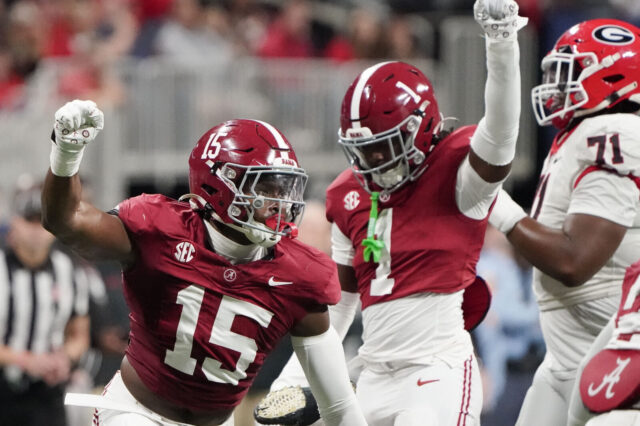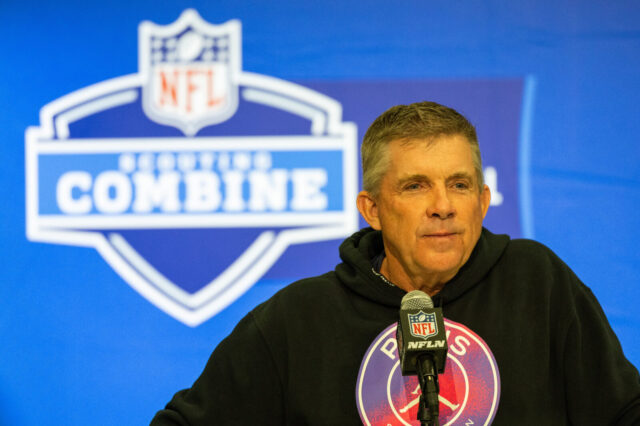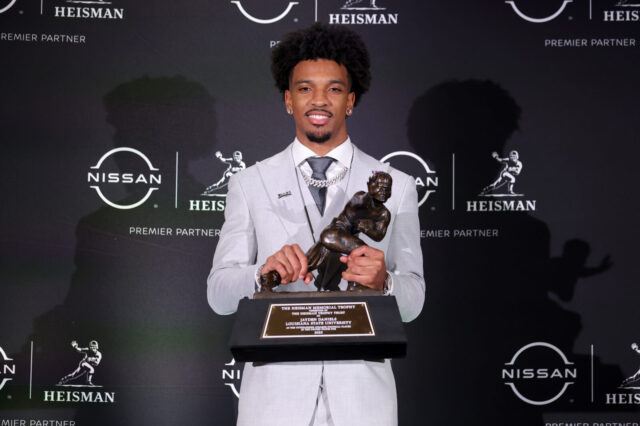This story originally appeared in Mile High Sports Magazine. Read the full digital edition.
“Tebow to Demaryius.”
When spoken in Colorado, those three words are instantly understood. There’s no need, in this space or elsewhere, to further explain. People just know. These words are part of the lexicon, not unlike “The Drive” or “The Fumble” or “This one’s for John.” Each of those phrases conjures a single moment, a vivid image, a precise time and place, an emotion.
But there was a time when Demaryius Thomas didn’t understand just how significant those three words were, or would become.
If memory serves, on the night of April 18, 2012, 101 days after his instantly famous, 80-yard, game-winning, overtime touchdown, Thomas had yet to grasp the magnitude of that life-changing play.
On that particular night, inside Corridor 44 on Denver’s Larimer Street, Thomas sat in a tall booth near the back of the room. He had just taken in the Nuggets-Clippers game with some of his Broncos teammates. As his group dwindled over time, Thomas and a few friends headed across Speer Boulevard for a bite to eat. The quaint but classy champagne bar was always dimly lit, but that’s not why Thomas, despite having made the biggest sports play Denver had witnessed in quite some time, went relatively unnoticed.
His body was unmistakably that of an NFL star, but his presence upon entering a room was always understated, never flashy. Even on that night, sitting in the middle of five or six friends, he wasn’t holding court. He never did; that wasn’t his style.
That he was a 2010 first-round draft choice of Denver’s favorite team didn’t matter; that hype had faded after two seasons marred by injury. By the end of his second season he was finally healthy, but playing in Denver’s run-heavy offense. He was only a “piece,” certainly not the centerpiece. If he was a household name, it was only in Denver, and even there, his face was recognized only by the team’s truest fans.
So, the conversation taking place in Corridor 44’s dimly lit back booth was not unlike the banter heard – or not – between the bar’s other inhabitants. Thomas did not create a stir, much less a scene; nobody awkwardly peered over, trying to decide if he was someone they should know.
Inside the booth, however, the discussion, as it regularly had ever since Jan. 8, somehow steered toward the play. Friend, fan or acquaintance, everyone wanted to know about “Tebow to Demaryius.”
“I feel like more people notice me since that play,” Thomas told the person to his immediate right.
“You don’t have any idea how big that play was, do you?” they asked. “I don’t think you realize what it meant to Denver, to the resurgence of the Broncos. It’s been awhile since something like that happened here – probably since 2005, but even that was nowhere near as exciting. That was like the stuff that used to happen at old Mile High.
“Trust me, that play makes you a hero in these parts.”
“I don’t know,” Thomas shrugged. “I’m not sure Denver wants me.”
Two years of injuries and frustration paired with inconsistent production – in his mind – had not been erased by the one, albeit legendary, touchdown that followed. Up to that point, he’d managed just seven regular season starts and 834 receiving yards over two seasons. Quietly, he wondered if the team had ever considered trading him, or if they’d opt to resign him once his rookie contract expired. He hoped he could stay healthy. Would the 297 yards he’d tallied in two playoff games really even matter? He pondered, as if he’d already considered it many times before, where his professional career might eventually take him.
“Maybe Atlanta,” he mumbled.
***
Demaryius Thomas has been to Atlanta plenty of times since that night, but in the four years that have passed he’s gone back to play football just once. His lone encounter with the Falcons came early in the 2012 season – Peyton Manning’s second game as a Bronco – when Thomas had eight catches for 78 yards and a touchdown. It’s probably safe to assume he hasn’t thought much about the Falcons since. He’s a Bronco through and through.
And why shouldn’t he be? Thomas enters 2016 as Denver’s longest-tenured player. He hasn’t missed a start since Week 14 of the 2011 season. That includes 10 playoff games, two Super Bowl appearances and one big, fat ring. Shaky beginnings have morphed into the rock solid foundation of the Broncos.
Thomas recalls the wise words of friend and former teammate Champ Bailey: “Man, you’ll be in your seventh or eighth year before you know it. The next thing you know, you’re the old guy.”
Thomas isn’t old; he’ll be 29 this Christmas, but he is entering his seventh year in the NFL. Just as Bailey warned, he’s now “the old guy.”
In many ways, not much has changed about Thomas. He’s still quiet. Still unassuming. Still humble.
As a young player, he used to conduct kids camps with teammate Eric Decker. Decker departed for the Jets after the 2013 season, but Thomas still puts on the camp every summer.
He still lives in the same modest home, the first and only one he’s purchased in Denver. He suggests that he might sell it and move soon, but once the season starts, that might become a pain. He’s not really sure where he’d move if he did.
It’s not that he’s limited in his options. There are few houses in Colorado he couldn’t afford, although it’s unlikely he’d consider anything overly extravagant. That’s never been the modus operandi of the kid who grew up in poor, rural South Georgia, bouncing from one home to another. After inking a five-year, $70 million contract (with an $11 million signing bonus and $43.75 million guaranteed) last July, home shopping should be easy.
“You know, I had money I never thought I’d have,” he says referring to his rookie contract – not the one that has him set for life.
He couldn’t have earned – and the Broncos wouldn’t have offered – a contract that makes him the highest-paid member of the team this season, or the third-highest-paid receiver in the NFL, if some things hadn’t changed, however.
The nagging injuries that limited his playing time early on have all healed. In the “Tebow to Demaryius” game, Thomas posted 204 receiving yards – still a Broncos playoff record – and hasn’t looked back since. The Peyton Manning Era in Denver ushered in a passing attack that quickly placed Thomas in the conversation of the league’s most-prolific pass catchers.
Thomas is the only active wideout in the NFL to have amassed 1,300-plus receiving yards in four consecutive seasons (and counting). In the history of the game, Jerry Rice, Marvin Harrison and Thomas are the only players to ever claim four consecutive seasons of at least 90 catches and 1,300 yards.
With the Broncos, he holds most every significant single-season receiving record – most yards in a season (1,619 in 2014), most yards in a single game (226 vs. Arizona on Oct. 5, 2014), most touchdown receptions in a season (14 in 2013). He’s second only to Rod Smith in single-season catches; in 2001 Smith hauled in 113; Thomas caught 111 in 2014. Over Smith’s 13 seasons as a Bronco, he compiled 849 receptions, 11,389 yards and 68 touchdowns. Just six years in, Thomas is well on pace to catch the player from whom he sought advice as a rookie. His career totals entering the 2016 campaign are impressive: 456 catches (fifth in franchise history), 6,621 yards (fourth) and 47 touchdowns (third).
Early in his career, Thomas heard more than once that he was a bust. Now, he’s a three-time Pro Bowler, a two-time All-Pro selection and a Super Bowl Champion. In 2015, a season in which the franchise hoisted its third Lombardi Trophy, Thomas received criticism for an unusually high number of dropped passes. People wondered what had happened to the sure-handed receiver.
“I don’t consider myself fallen off. It just wasn’t my best year. You know, I had 11 drops,” Thomas says, as if each of them has been safely tucked away in his memory.
Still, his 105 catches ranked seventh in the league, as did his 1,304 yards. It wasn’t his best year, but it would be considered a career year for many. There have been only two seasons in which a Broncos receiver had more catches – he claims one of those – and nine seasons in which a Broncos receiver had more receiving yards – three of them are his.
In no uncertain terms, Thomas has been the picture of consistency in Denver.
He is asked, a month before the season, if he recalls that night in the back booth at Corridor 44.
He does.
He remembers feeling uncertain, perhaps even unconfident, dwelling on the missed time from injuries, wondering how long he’d be a Bronco – never considering the possibility that he’d one day be the team’s sturdiest veteran or that he’d be getting paid – like this – for his accomplishments.
Thinking back, he laughs. He offers his bright, signature smile and provides a notion that brings everything full circle.
“It feels good now.”
***
The Demaryius Thomas who honestly and openly shared his trepidation in the spring of 2012 surely didn’t foresee the many paths that he’d take.
Coming from a run-heavy offense at Georgia Tech, then getting thrust into the Tim Tebow Experiment, certainly didn’t prepare him for life with Peyton Manning. There’s no way he could have imagined, then, that he’d one day catch Manning’s record-breaking touchdown pass – No. 509 – or that when it was all said and done, he’d rank third among Manning’s favorite targets with 36 touchdown catches; only Marvin Harrison (67) and Dallas Clark (44) had more. In his wildest dreams, he couldn’t have envisioned himself starring in a Gatorade commercial series dubbed “Dear Peyton.”
After his rookie season, in which he caught just 22 passes and his team won a mere four games, the idea that he’d soon set a Super Bowl record for most receptions in a single game (13 vs. Seattle), or that he’d play in two and win one, surely seemed far-fetched.
That Super Bowl victory earned him a trip to the White House, but what makes his appearance at 1600 Pennsylvania Avenue even more bizarre is that he already had relationship with the man who lived there. Could Thomas have ever – ever, ever – dreamt that his own celebrity – and his story, which national journalists loved and so passionately told – would likely be the catalyst for the President of the United States to consider commuting the prison sentences first of his mother and then his grandmother?
When Atlanta popped into his mind as a logical “next place,” just in case Denver said goodbye, it made sense. Why wouldn’t it? He was from there, Matt Ryan was a solid quarterback and Roddy White’s retirement couldn’t be that far off. But there’s no way on earth he could have pictured himself taking a tour of Africa.
Seeing the sun rise and set from Capetown.
Being awakened at night at the Sabi Sands Game Reserve while baboons tried to sneak into his bungalow, or watching lions chase down an intruder just feet from his safari jeep.
Visiting District 6’s Langa Township and witnessing poverty that made his South Georgia upbringing seem more palatable.
“You’ve got people – hundreds of people – standing in small, little places. A family of five, and they don’t have bathrooms and they have one bed. It was just crazy,” he would later say. “That made me respect where I’m at right now, because people got it bad. We’re always over here complaining about little things, and you’ve got people over there going to a tunnel to use the bathroom in front of everybody. That gave me a different perspective about what I have to go through.”
Or being touched by stepping into Nelson Mandela’s jail cell on Robben Island.
All of it, incomprehensible just four short years ago. It had to be.
The trip to Africa tells a bigger story than what fans saw on Instagram. It had been in the works since training camp of 2015. The idea was hatched by veteran DeMarcus Ware, who says planning such a trip throughout the year took their minds off of football. It built a strong bond and gave them something to look forward to. The only caveat was that they’d only go if they won the Super Bowl.
“We wanted to go see something different,” Ware says. “And that’s what we got.”
That Thomas has befriended Ware, who’s entering the twilight of his career at age 34, is nothing unusual. Throughout his career, Thomas has made a habit of surrounding himself with veteran leaders. Long before his first NFL snap, he trained with Larry Fitzgerald and Calvin Johnson. When he arrived in Denver he consulted Smith. It’s as much a philosophy as it is a pattern.
“I just continue to have older guys around me,” he says, “like Champ [Bailey], Peyton [Manning], Brian [Dawkins]. I always put myself around the older guy even though I’ve been in the league a long time – just to figure out how to go about being a pro.”
Bailey will enter his second year of retirement when the Broncos kick off the season, but he still hears regularly from Thomas, who can tell him things he might not be able to tell coaches or teammates.
“What really gravitated me toward [Demaryius] was that he’s a South Georgia kid,” says Bailey, a Georgia native who grew up just an hour and a half north of Thomas and played his college ball at the University of Georgia. “Growing up in South Georgia, you know the type of mentality he had. Hard work, grind – I mean, that’s all you know. Because that’s all everybody around you does. So, those are his influences. Plus, you don’t have a lot of resources down there, or opportunity.
“You’re either playing sports, or you’re going to stay there the rest of your life.”
Thomas made it out. When he landed in the NFL, Bailey was waiting.
“It was more of a friendship than a mentor mentality,” says Bailey. “I didn’t really have to tell him how to work, or tell him what it means to be a professional. I just had to show him and he got it. He’s just one of those kids; he was just a little more mature than the average rookie. I wasn’t worrying about him getting in trouble or telling him how to avoid this or that; he kind of had that part figured out.”
Thomas is an old soul. Mature. Intelligent. Before being drafted, he had the 10th-highest Wonderlic score of any player at the NFL scouting combine with a score of 34 – well above the average for a wide receiver.
Following Super Bowl 50, he did not respond like the typical 29-year-old might. He did not go to Las Vegas. He did not have, as Manning jokingly dubbed Von Miller’s summer, “a celebrity tour.” His trip to Africa spoke volumes of who he is and why he’s been so successful.
“In talking to Demaryius, the mind is one of the most important things,” says Ware, who grew more impressed with Thomas during their trip. “If you feed it, you get smarter, but also you make better decisions. Either you can be on the highway with everybody going the same direction, or you can be in the HOV lane, where it’s only you and the person carpooling with you – and that’s the faster way to go. That’s how we’re trying to live.”
“Tebow to Demaryius” showed the world just how fast Thomas could be. The play did not, however, immediately convince him that he would get here so fast. Ware’s HOV analogy describes more astutely how Thomas has done it.
“It’s no secret formula to him getting 1300-plus yards all these years in a row,” says Bailey. “It’s ridiculous that anybody would expect anything less, because that’s the way he prepares. He’s built that way, mentally, to handle the pressures of the NFL.”
Since he entered the league in 2010, there’s always been something to overcome – injuries, a lawsuit involving teammate Perrish Cox, offenses, expectations, a belief that he and his team were “soft” following Super Bowl XLVIII, the death of his grandmother on the eve of training camp 2014, contract distractions. As Bailey says, “There’s always something.”
Eleven drops and adjusting to a new quarterback? Add them to the list. They are challenges that, if history is an indicator, Thomas will meet.
“He’s one of those guys who has a big heart,” says Ware. “But he also has the tenacity to come out here and prove a point – that he deserves this.
“He started from the bottom of the barrel and crawled out of there.”



